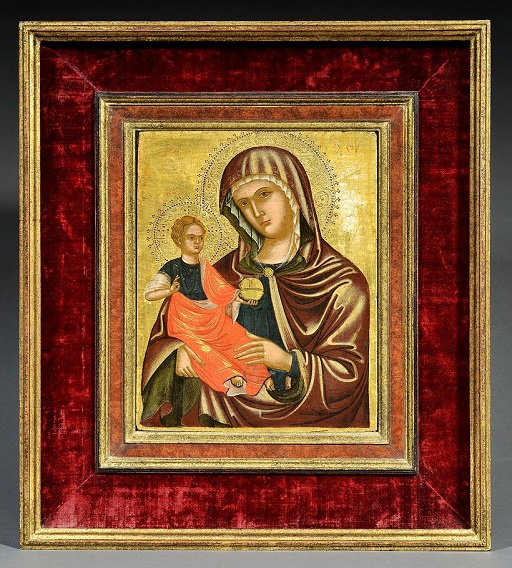3.5 Madre della Consolazione
Another characteristic example is the Virgin and Child in the type of the Madre della Consolazione (Figure 9), one of the many variations of the Virgin Hodegetria. It was named after an Italian frescoed icon of the fifteenth century found in the church of Santa Maria della Consolazione in Rome – although the Cretan type is only loosely based on its Roman source (Lymberopoulou, 2003; Lymberopoulou, 2007a, p. 189-190; and Lymberopoulou, 2007c, p. 208). It is possible that a small, portable reproduction of the painting found its way to Crete via the busy Venice-Candia sea route.

Madre della Consolazione’s characteristic features are her ‘Giottesque’ appearance (i.e., figures resembling those created by the fourteenth-century Italian painter Giotto, with the major characteristic being bulkiness – a simple internet search will bring up countless examples of Giotto’s art, or see Derbes and Sandona (2014) for an overview of his artistic achievements), which differs from the ‘slender’ look she usually assumes in Byzantine art. At the same time, she maintains her aloofness – one of the most typical characteristics of a Byzantine Virgin. The brooch which holds the Virgin’s maphorion (mantle) together in front of her chest, and the kerchief with its stylised edges which the Virgin wears on her head underneath her maphorion, are both western ‘loans’ which do not form part of her attire in Byzantine art. The patterns on the Child’s chiton, too, which imitate decorative motives, are found in Italian fabrics and painting. The type was one of the major sellers in the European icon market in the late fifteenth century. It is assumed that this is the type of the 700 icons of the Virgin that were commissioned by two dealers, Giorgio Basejo from Venice and Petro Varsama from the Peloponnese, and destined for the European Renaissance market. This information is provided by a well-known and well-published archival document, comprising three separate contracts, all dated 4th July 1499. This huge number of icons was commissioned to three different Cretan painters who had 42 days to deliver the order. Two painters were contracted to produce 200 icons each, while a third was asked to deliver 300 (Lymberopoulou, 2007a, p. 188-192; Richardson, Woods and Franklin, 2007, p. 371-373; Lymberopoulou, 2022, pp. 159-162).
It’s no coincidence that the icons depicted the Virgin and Child. As you saw in Section 2.2, icons of the Virgin and Child were by far the most popular, as it was believed that the very first such icon, an acheiropoietos, had been painted by Saint Luke. In any case, Catholic faithful were familiar with the concept of keeping devotional paintings in their bedrooms. Icons were popular even among important Italian Renaissance patrons, such as Lorenzo di Medici (Duits, 2013). This is significant given that Giorgio Vasari – the Italian sixteenth-century author considered to be the first art historian – credited Italy (and in particular Florence) with the Renaissance ‘miracle’, and at the same time condemned the artistic quality of icons.
The popularity of icons in the Italian peninsula prevailed; the Italian scholar Giuseppe Gerola stated in the early twentieth century that ‘every Venetian family had an icon’ (1908, vol. 2, p. 312).
